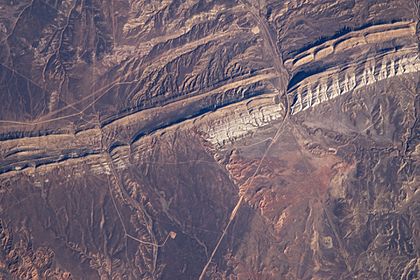Raven Ridge facts for kids
Raven Ridge is a very clear rock formation you can see in Rio Blanco County, Colorado and Uintah County, Utah, USA. It's like a long, narrow hill made of rock. The Bureau of Land Management takes care of this area. Raven Ridge is special because it has many rare plants that grow only in Colorado.
Contents
What is Raven Ridge Made Of?
Raven Ridge and another nearby ridge, Squaw Ridge, are like open books showing Earth's past. These rock layers were formed about 53 to 49 million years ago. They became visible because of big movements in the Earth's crust much later.
How Rocks Tell Earth's Story
These rocks show us what the Earth was like during the early and middle parts of the Eocene time period. This was a long time ago! During the Eocene, animals like early horses, primates (like monkeys), and rodents were common here. At the southern part of Raven Ridge, you can even find coal beds right on the surface.
How Raven Ridge Was Formed
The rocks at Raven Ridge first formed as flat layers of sedimentary rock. This happened near a shoreline in an area called the Uinta Basin. Later, huge forces from the Laramide Orogeny pushed and folded these layers. This made them tilt almost straight up, creating the ridge we see today.
Amazing Plants of Raven Ridge
Raven Ridge is home to eight very rare plant species. These plants are endemic, which means they grow naturally only in this specific area.
Unique Plant Species
Here are some of the special plants found at Raven Ridge:
- Penstemon grahamii (Graham's beardtongue)
- Penstemon albifluvis (White River beardtongue)
- Astragalus lutosus (Dragon milkvetch)
- Aquilegia barnebyi (Mancos columbine)
- Cryptantha rollinsii (Rollins's catseye)
- Parthenium ligulata (Colorado feverfew)
- Eriogonum ephedroides (ephedra buckwheat)
- Phacelia incana (hoary phacelia)
Many other types of plants also grow in this unique environment.
Fossils Found at Raven Ridge
At the very top of Raven Ridge, you can find many perfectly preserved fossils. These fossils are mostly gastropods, which are a type of snail. Finding so many well-preserved fossils helps scientists learn more about ancient life.


